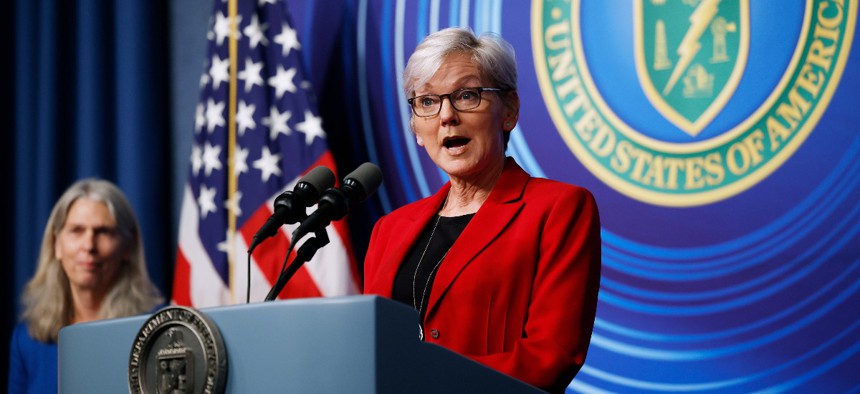Historic Fusion Ignition Promises Innovation in Clean Energy, National Security

U.S. Energy Secretary Jennifer Granholm (R) is joined by National Nuclear Security Administration head Jill Hruby and other officials for a news conference at the Department of Energy headquarters to announce a breakthrough in fusion research on December 13, 2022 in Washington, DC. Chip Somodevilla/Getty Images
The breakthrough fusion experiment conducted last week at the Lawrence Livermore National Laboratory stands to change the U.S.’ national security posture and sustainable energy development.
A group of American scientists has achieved a milestone in nuclear fusion, fueling hopes for the alternative power source’s potential as a sustainable alternative to fossil fuels.
On Tuesday, Secretary of Energy Jennifer Granholm introduced the news alongside other agency officials and scientists from the Lawrence Livermore National Laboratory, where the innovation in fusion technology occurred over a week ago.
The team at the LLNL achieved what is known as a scientific energy breakeven, where the fusion experiment resulted in a greater production of energy than the input used to operate its lasers, achieving fusion ignition.
As a self-sustaining reaction to atomic collision under intense heat, fusion ignition has the potential to be used as a source of clean energy. Specifically, 3.15 megajoules of energy were generated with an input of 2.05 megajoules and laser technologies––something never achieved anywhere in the world.
“This is a landmark achievement for the researchers and staff at the National Ignition Facility who have dedicated their careers to seeing fusion ignition become a reality, and this milestone will undoubtedly spark even more discovery,” Granholm said in the formal press release.
Kim Goodell, the director of LLNL, described this “historic achievement” as the culmination of 60 years of scientific work at the national laboratory. The first sign of fusion ignition for Goodell’s team occurred last August, when the lasers used in fusion experiments generated a record number of 1.35 megajoules.
Current nuclear power plants rely on nuclear fission, which splits apart larger atoms to generate energy. Nuclear fusion instead combines two atoms and doesn’t produce the radioactive byproducts created by fission, according to the Department of Energy website.
Just before scientists recorded fusion ignition last week, Goodell said that prediction data collected from machine learning algorithms indicated that success was on the horizon.
“This achievement opens up new scientific realms for us to explore and advances our capabilities for our national security missions,” she said. “It demonstrates the power of U.S. leadership and science and technology and shows what we're capable of as a nation.”
In addition to supporting further research for clean energy, fusion ignition also has major national security ramifications, as Goodell highlighted. This breakthrough is set to help contribute to other federal research programs, specifically the Stockpile Stewardship Program, a collection of nuclear weaponry maintained by the National Nuclear Security Administration.
“In achieving ignition, the researchers at Lawrence Livermore have opened a new chapter in NNSA’s science-based Stockpile Stewardship Program, enabling us to study new regimes,” Jill Hruby, the administrator of the NNSA said in Tuesday’s press briefing.
Marvin Adams, the deputy administrator for defense programs at Energy, added that this advance in fusion technology will help federal researchers understand the reactions of nuclear deterrents without explosive testing, and will inspire more international confidence in American defense forces.
Investing in fusion technology is one of the Biden administration’s chief priorities, given its benefits as a potential clean energy source that stands to help his goals of a net zero emission economy by 2050. Administration officials have also discussed their hopes for fusion technology’s impact, with the Office of Science and Technology Policy’s Sally Benson citing about $5 billion in private sector investment.
Despite this major innovation, Goodell told reporters that the U.S. is still far off from the commercialized and wide-scale usage of fusion energy.
“There is a pathway to a target that produces enough yield, but we're very distant from that right now,” she said.
Granholm added that the private sector’s engagement can help expedite the potential for fusion energy to be commercialized, and cited President Joe Biden’s plan to develop a commercial fusion reactor within a decade.
“We've got to get to work, and this…shows that it can be done, which has been a question,” she said.




